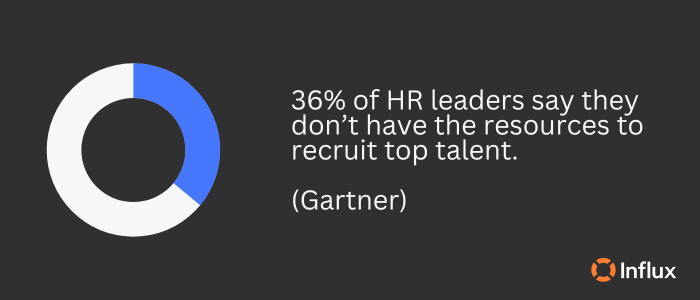Need a quick hiring solution? We can get started in under a week with flexible, on-demand support.
Businesses in need of customer support have two options: hire talent internally or outsource to a service provider. While there are pros and cons to hiring vs. outsourcing—and businesses should consider both—there’s not always a right or wrong answer to which is best for your business.
The hidden costs in the hiring process like advertising, time investments, training, or turnovers can stack up significantly and end up costing much more than a service provider would charge.
Whether you’re launching earlier for the holiday season, scaling customer support, or looking to clear the backlog, understanding the costs of hiring and outsourcing is a big factor in the decision making process.
We’ve curated a list of 2023 stats on the cost of hiring customer support that will help you make the right choice.
The costs and challenges of HR
Cost savings of outsourced support
The cost of hiring customer support agents
Recruitment challenges
Recruiting can be quite a burden for businesses, given how competitive the market is. On top of that, it’s not easy to find and attract diverse talent with the skills and experience needed to succeed. Simply, a majority of businesses are struggling. Here’s what the numbers have to say.
- 57% of support leaders are finding it hard to recruit and retain high quality support agents right now.
- 36% of HR leaders say they don’t have the resources to recruit top talent.
- 50% of organizations think the competition for talent is likely to increase in the next six months.
- On average, each corporate job offer attracts 250 resumes. Of those candidates, 4 to 6 will get called for an interview, and only one will get the job.

The costs and challenges of HR
It’s expensive to find and onboard new employees. When businesses need to fill a role fast, it can cut into the search for a capable candidate and result in a hasty hire. Your team is probably facing some of these same challenges.
- 46% of respondents confirmed that 2023 would see further decreases in office space, over half (59%) plan to reduce their office spaces.
- 97% of companies are planning bigger investments in recruitment technologies in the coming 2023 year, with 47% investing in AI technologies.
- Hiring an employee in a company with 0-500 people costs an average of $7,645.
- The average cost to hire an employee is $4,129, with around 42 days to fill a position.
- It costs an average of $1,400 to onboard a new employee. The cost is more burdensome for small businesses with under 1,000 employees, as they have fewer resources for training. For large enterprises with over 10,000 employees, the cost of onboarding is about half as much.
- Overall, it takes around six months for a company to break even on a new hire.
- LinkedIn remains the best recruiting platform for professional roles in 2023. The subscription to LinkedIn Recruiter Lite costs $170 monthly or $1,680 annually.
The cost of a bad hire
It goes without saying that a bad hire can affect a team in a number of ways, but the cost of a bad hire is something to be cautious of when considering whether to hire or outsource customer support. Check it out.
- A bad hire can cost up to 30% of the employee’s wages for the first year.
- 34% of CFOs said that not only do bad hires cost them productivity, but managers also have to spend 17% of their time supervising poorly-performing employees.
- Almost three-quarters of companies who made a bad hire reported an average of $14,900 in wasted money. With 74% of employers stating they hired the wrong person for the job.
- The average cost of a bad hire ranges from $17,000 to $240,000.
- Nearly 60% of bad hires went wrong because the employee could not produce the level of work required by the employer.
- 30% of new hires leave within 90 days. The reasons employees leave are 43% say the role doesn’t meet their expectations, 34% leave because of a specific incident and 32% don’t think the company culture is a good fit. It costs 33% of an employee’s salary to replace them.
- The turnover rate for frontline contact center employees is high at 58%, with some verticals seeing turnover reach as high as 85%.
Cost savings of outsourced support
Many businesses choose to outsource their customer support to bypass recruitment, training, and management. Outsourcing is also a popular choice to get access to a team of experts and as a cost-effective solution. See for yourself.
- Companies in Western developed countries can save around 30% to 90% of development costs if they outsource business functions to developing countries.
- Almost 27% of organizations outsource to reduce costs.
- Outsourcing can help businesses save up to 30% on their entire operating costs.
- 27% of small businesses are most motivated to outsource in hopes of improving their efficiency and saving time.
- 33% of small businesses outsource in order to access flexible resources, indicating that small businesses value short-term and seasonal workers.
- 70% of brands that use outsourcing list their top reason as cost reduction. The second reason is flexibility, with 40% of businesses saying this is important to them, and the third most popular reason is speed, with 20% of businesses listing that as their number one priority for outsourcing.
- 37% of small businesses outsource a business process. This helps them manage their tasks without overwhelming internal teams or having to go over budget to hire new employees.
- Roughly 59% of businesses are happy with outsourcing work because it saves money and is an effective cost-cutting tool.
The cost of hiring customer support agents
If you’re considering hiring customer support agents, these stats will give you an estimate of just how much it may cost.
- Glassdoor estimates the average customer service representative earns $33,648 per year, plus $5,000 in benefits.
- Including costs such as taxes, recruiting, onboarding, training, and allocable costs like supervisory, IT, HR, and others, the average per-hour rate for customer service agents in the US is between $30- $40 per hour.
- Small business owners spend around 40% of their working hours on tasks that do not generate income, such as hiring.
- Here are the average customer service training costs:
- The purchase of customer service training materials: Spend as little as $100 or as much as $1,000.
- An online course with on-demand video: Spend as little as $10 per employee.
- Customer service software: Costs may be as low as $80 for general customer service training software or as high as $1,000 for highly specialized training.
- Virtual training with a live instructor: Costs can range from $1,500 (for up to six people) to $2,250 for up to 24 people.
- A full day of onsite in-person training: Spend between $500 and $1,500 per employee and may incur business travel.
Need a quick solution?
Outsourcing is a quick, flexible, and cost-effective solution to hiring difficulties. Get started in under 1 week with on-demand support and full, global coverage that perfectly matches your brand.
What do you think? Do the benefits and cost savings of outsourcing align with your business goals? If yes, we’d love to talk with you about how it works.



